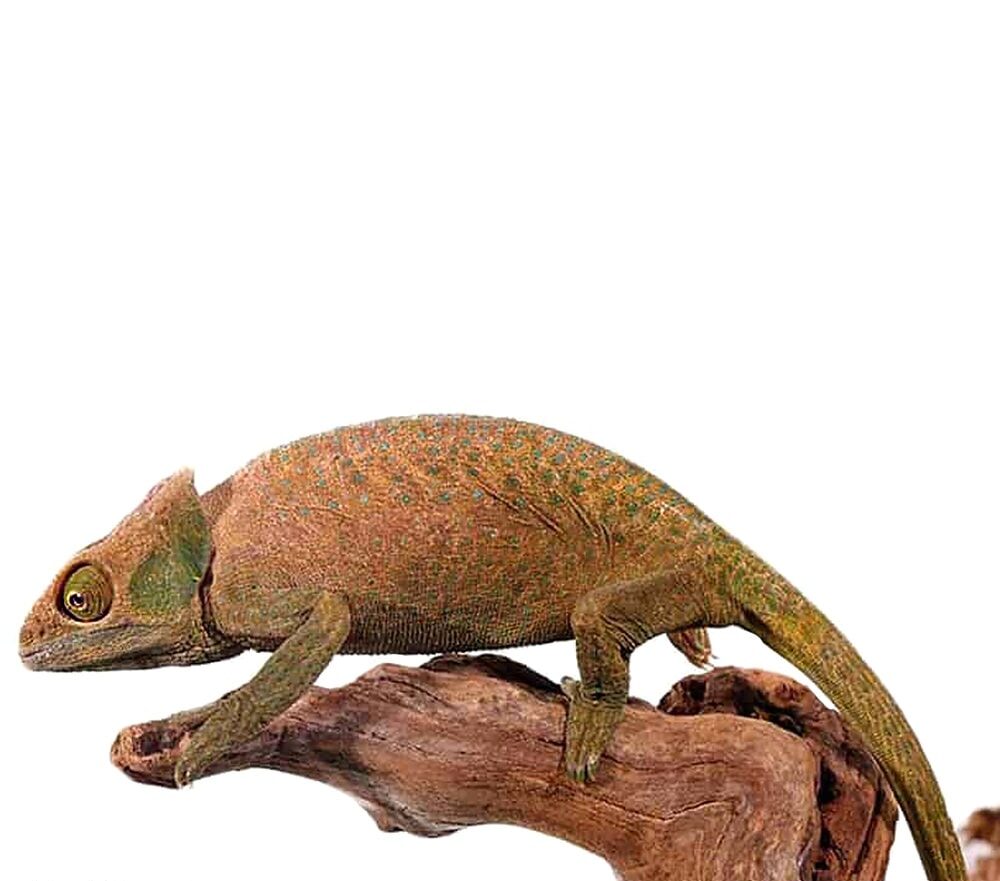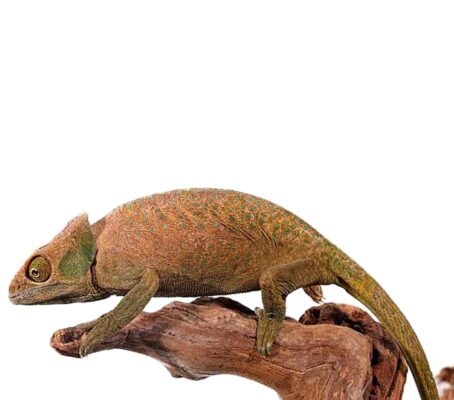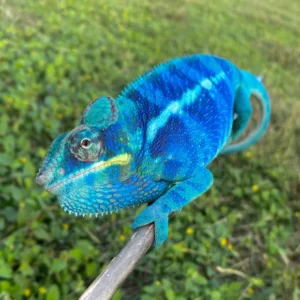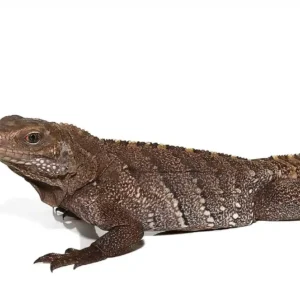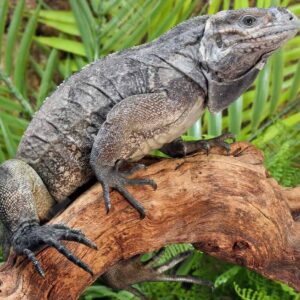OShaughnessys Chameleon For Sale
$599.99
WE HAVE OSHAUGHNESSYS CHAMELEON FOR SALE. HERE ARE SOME HIGHLIGHTS:
- Calumma oshaughnessyi
- Captive Bred
- Approximately 13-14 Inches In Length From Head To Tail
- Able To Capture Its Prey From A Distance By Shooting Its Tongue Like A Harpoon
- Precision Hunters Feeding On Crickets Regularly
FUN FACTS!
- Originating Out Of The Island Of Madagascar
- Amazing Chameleons Being More Active In The Morning And Evening Hours Hunting For Food And Finding Mates
- Living In Humid Forests Filled With Dense Foliage High In The Trees, We Recommend Lots Of Branches For Climbing And Foliage For Security And Cover
- Kings Of Camouflage Being Able To Change Color With Temperature, Environment, And Mating
Description
O’Shaughnessy’s Chameleon, scientifically known as Calumma oshaughnessyi, is a remarkable species within the Chamaeleonidae family. This chameleon is named in honor of the British herpetologist Arthur O’Shaughnessy, reflecting its rich scientific heritage. Taxonomically, it falls under the genus Calumma, which is exclusively found in Madagascar, a biodiversity hotspot that harbors a plethora of unique flora and fauna.
The habitat of O’Shaughnessy’s Chameleon is primarily confined to the rainforests of eastern Madagascar. These rainforests provide the ideal conditions for the chameleon, including high humidity, dense foliage, and a diverse array of insects that constitute its diet. This species is arboreal, spending most of its life in the tree canopy, where it exhibits remarkable adaptations for climbing and camouflage.
Geographically, O’Shaughnessy’s Chameleon is distributed across a relatively narrow range, making it a species of particular interest for conservationists. The chameleon’s restricted distribution, coupled with habitat loss due to deforestation, has raised concerns about its long-term survival. Efforts are underway to study and protect this enigmatic species, ensuring that it continues to play its vital role in the ecosystem.
Distinctive features of O’Shaughnessy’s Chameleon include its vibrant coloration, which can range from shades of green and blue to yellow and brown, depending on various factors such as mood, temperature, and environment. This color-changing ability not only aids in camouflage but also plays a crucial role in communication and mating behaviors.
Understanding the importance of O’Shaughnessy’s Chameleon within its ecosystem is essential. As an insectivore, it helps regulate insect populations, thus maintaining ecological balance. Moreover, its presence indicates a healthy rainforest ecosystem, making it a key species for monitoring environmental health.
Physical Characteristics and Adaptations
O’Shaughnessy’s Chameleon, scientifically known as Calumma oshaughnessyi, exhibits a remarkable array of physical features and adaptations that make it a fascinating subject of study. This chameleon species typically measures between 25 to 30 centimeters in length, with males generally being larger than females. The size difference is a clear example of sexual dimorphism, which is prevalent in this species. Males also tend to possess more vibrant colorations compared to the often more subdued hues of females.
One of the most striking characteristics of O’Shaughnessy’s Chameleon is its ability to change color. This adaptation is not merely for camouflage but also plays a crucial role in communication and temperature regulation. The color variations can range from shades of green and brown to more vibrant colors like blue and yellow, depending on the chameleon’s mood, health, and environmental conditions.
Another unique adaptation of this species is its prehensile tail, which functions almost like a fifth limb. This tail allows the chameleon to grasp and stabilize itself on branches, providing enhanced mobility and stability as it navigates through its arboreal habitat. The prehensile tail is particularly beneficial in the dense foliage of Madagascar’s rainforests, where O’Shaughnessy’s Chameleon is predominantly found.
The independently mobile eyes of O’Shaughnessy’s Chameleon are another fascinating adaptation. Each eye can move separately, allowing the chameleon to have a 360-degree field of vision. This capability is crucial for spotting prey and avoiding predators. The chameleon’s eyes are also highly specialized for depth perception, enabling precise targeting when capturing insects with its long, sticky tongue.
Sexual dimorphism in O’Shaughnessy’s Chameleon extends beyond size and coloration. Males often exhibit more pronounced cranial crests and casque-like structures on their heads, which are used in territorial disputes and mating displays. These physical traits not only aid in survival but also play a significant role in the mating rituals of the species, ensuring the continuation of their genetic lineage.
Habitat and Distribution
O’Shaughnessy’s Chameleon, scientifically known as Calumma oshaughnessyi, thrives primarily in the dense rainforests of Madagascar. These lush, tropical forests provide an ideal environment for the chameleon, offering the necessary conditions for its survival and proliferation. The natural habitat of O’Shaughnessy’s Chameleon is characterized by high humidity, which is crucial for their well-being. Humidity levels typically range between 70% and 90%, mimicking the moist atmosphere of their rainforest home.
Temperature also plays a vital role in the chameleon’s habitat. The rainforests in Madagascar maintain a warm climate, with temperatures usually hovering between 22°C and 28°C (72°F to 82°F). This range is optimal for the physiological processes of the chameleon, including thermoregulation and metabolic functions. Additionally, the dense vegetation of the rainforest provides the necessary cover and abundant food sources, such as insects, which are integral to the chameleon’s diet.
Despite these favorable conditions, OShaughnessys Chameleon faces significant challenges due to habitat destruction and climate change. Deforestation in Madagascar, driven by agricultural expansion, logging, and urban development, has led to the fragmentation of the rainforest. This not only reduces the available habitat for the chameleons but also isolates populations, making it difficult for them to find mates and maintain genetic diversity. Furthermore, climate change poses a threat by altering the temperature and humidity levels of the rainforest, potentially disrupting the delicate balance required for the chameleon’s survival.
Conservation efforts are crucial to protect the natural habitat of OShaughnessys Chameleon. Initiatives aimed at preserving the rainforests and mitigating the impacts of climate change are essential for the long-term survival of this unique species. By understanding and addressing the environmental challenges faced by O’Shaughnessy’s Chameleon, we can contribute to the conservation of this fascinating creature and its rainforest ecosystem.
Diet and Feeding Behavior
OShaughnessys Chameleon, a species native to Madagascar, exhibits intriguing dietary habits that are essential for its survival. Primarily, this chameleon subsists on a diet of insects and other small invertebrates. Its prey includes a variety of arthropods such as crickets, locusts, beetles, and spiders, which provide the necessary nutrients for its growth and overall health.
One of the most captivating aspects of OShaughnessys Chameleons feeding behavior is its hunting technique. The chameleon employs a specialized long, sticky tongue, capable of extending rapidly to capture prey from a considerable distance. This tongue functions almost like a projectile, reaching out to snatch insects with remarkable precision and speed. The adhesive quality of the tongue ensures that the prey is securely caught and can be retracted into the chameleon’s mouth for consumption.
The diet of OShaughnessys Chameleon is not static but varies with age and environmental conditions. Juvenile chameleons tend to consume smaller insects, as their developing bodies require a different nutritional profile compared to adults. As they mature, their dietary needs change, leading them to hunt larger prey more frequently. Additionally, environmental factors such as seasonal variations and habitat changes influence the availability of food sources, prompting the chameleon to adapt its feeding behavior accordingly.
Moreover, OShaughnessys Chameleon exhibits a level of opportunistic feeding behavior, meaning that it will adjust its diet based on the abundance or scarcity of certain prey types. This adaptability is crucial for its survival, especially in the diverse and often unpredictable ecosystems of Madagascar. Through these dynamic feeding strategies, OShaughnessys Chameleon maintains its nutritional balance and supports its various physiological functions.
Reproduction and Life Cycle
OShaughnessys Chameleon exhibits a fascinating array of reproductive behaviors, integral to understanding its life cycle. Courtship rituals commence with the male displaying bright colors to attract a female, often accompanied by head bobbing and other dynamic movements. This visual display serves not only to entice the female but also to ward off rival males. Successful courtship culminates in mating, a process that can last several hours.
Following mating, the female undergoes a gestation period lasting several weeks. OShaughnessys Chameleons are oviparous, meaning they lay eggs rather than giving birth to live young. The female typically finds a secluded, moist area to dig a shallow burrow where she deposits her clutch of eggs. The number of eggs can vary, but it generally ranges from 15 to 30 per clutch. Post-laying, the eggs enter an incubation period that can last from six to nine months, highly dependent on environmental factors such as temperature and humidity.
The hatching process marks the beginning of the developmental stages from hatchling to adult. Upon hatching, young chameleons are remarkably independent, possessing the ability to hunt and fend for themselves almost immediately. Juvenile chameleons undergo several molts as they grow, shedding their skin to accommodate their increasing size. This growth phase is critical, as it is during this time that they develop the vibrant coloration characteristic of adults.
Seasonal changes play a pivotal role in the reproductive cycle of OShaughnessys Chameleon. In the wild, mating and egg-laying are often synchronized with the rainy season, which ensures that the hatchlings emerge during a period of abundant food resources. This seasonal timing is crucial for their survival and growth.
Breeding OShaughnessys Chameleons in captivity poses significant challenges. Replicating the precise environmental conditions required for successful reproduction can be difficult. Factors such as temperature, humidity, and photoperiod must be carefully regulated to mimic the chameleon’s natural habitat. Despite these challenges, advancements in husbandry techniques have made captive breeding more feasible, contributing to the conservation efforts for this remarkable species.
Behavior and Social Structure
OShaughnessys Chameleon exhibits a distinct set of behavioral patterns and social interactions, driven by its unique adaptations and environmental factors. This species is primarily known for its pronounced territoriality, with males often establishing and defending specific areas against intruders. Territorial disputes are typically resolved through displays of color changes and body language rather than physical confrontation. These visual signals serve as a non-verbal communication method, effectively asserting dominance or signaling submission.
Color changes in O’Shaughnessy’s Chameleon are not solely confined to territorial displays. These chameleons utilize their vibrant coloration to communicate a range of emotions and intentions, from signaling stress or aggression to attracting potential mates. The ability to alter their color also plays a crucial role in thermoregulation and camouflage, allowing them to blend seamlessly into their surroundings and avoid predators.
Daily activities of OShaughnessys Chameleon are largely dictated by their diurnal nature. These chameleons are most active during daylight hours, engaging in activities such as foraging, basking, and exploring their habitat. They typically rest during the night, seeking out secluded spots to remain hidden from nocturnal predators. Social interactions are relatively limited outside of mating periods, with individuals leading largely solitary lives.
Interaction with other species within their ecosystem is an important aspect of OShaughnessys Chameleon behavior. These chameleons primarily feed on a diet of insects, playing a critical role in controlling insect populations. They also serve as prey for larger predators, thus contributing to the ecological balance. In their natural habitat, O’Shaughnessy’s Chameleons must navigate a complex web of interactions, balancing their roles as both predator and prey.
Conservation Status and Threats
OShaughnessys Chameleon (Calumma oshaughnessyi) currently holds a conservation status of “Vulnerable” according to the International Union for Conservation of Nature (IUCN). This designation underscores the pressing need for protective measures to ensure the species’ survival. The primary threats facing OShaughnessys Chameleon stem from habitat loss, primarily due to deforestation for agricultural expansion, urban development, and logging activities. The fragmentation of their natural habitat severely limits their range, making it increasingly difficult for these chameleons to find suitable environments for feeding and breeding.
Another significant threat to OShaughnessys Chameleon is the illegal pet trade. Despite regulations, the high demand for exotic pets continues to drive the illicit capture and sale of these chameleons. The removal of individuals from their natural habitat not only reduces the wild population but also disrupts the ecological balance of the regions they inhabit. Furthermore, the stress and poor conditions often associated with illegal trading can result in high mortality rates.
Climate change presents an additional, albeit indirect, threat to OShaughnessys Chameleon. Shifts in temperature and weather patterns can alter the delicate ecosystems on which these chameleons depend. Changes in vegetation and the availability of prey species can adversely affect their survival and reproductive success.
Efforts to conserve OShaughnessys Chameleon are underway, involving various conservation organizations and government agencies. These initiatives include habitat restoration projects, stricter enforcement of wildlife trade regulations, and public education campaigns aimed at reducing the demand for exotic pets. Additionally, research programs dedicated to understanding the species’ ecology and behavior are crucial for developing effective conservation strategies.
Protecting OShaughnessys Chameleon requires a multifaceted approach, combining habitat preservation, legal enforcement, and community engagement. By addressing the primary threats and supporting ongoing conservation efforts, there is hope for securing a future for this remarkable species.
O’Shaughnessy’s Chameleon in Captivity
OShaughnessys Chameleon, a captivating and vibrant species, can be a rewarding addition to a dedicated enthusiast’s collection. However, maintaining these chameleons in captivity requires meticulous attention to their specific needs. A well-structured habitat is paramount. Enclosures should mimic their natural environment, incorporating vertical space for climbing and ample foliage for hiding. A terrarium of at least 24x24x48 inches is recommended for a single adult, with non-toxic plants like Ficus benjamina and pothos providing both aesthetic value and functional hiding spots.
Temperature and humidity control are critical for the wellbeing of OShaughnessys Chameleon. Daytime temperatures should range from 75-85°F, with a basking spot reaching up to 90°F. Nighttime temperatures should drop to around 65-70°F. Maintaining humidity levels between 50-70% is essential, achievable through regular misting and the use of a humidifier. Lighting is another crucial aspect; UVB lighting should be provided for 10-12 hours daily to facilitate calcium absorption and prevent metabolic bone disease.
The diet of OShaughnessys Chameleon should be varied and nutritious. A staple diet of gut-loaded crickets, supplemented with other insects such as waxworms, silkworms, and dubia roaches, ensures a balanced intake of necessary nutrients. Occasional supplementation with calcium and vitamin D3 is also necessary to support optimal health. Fresh, clean water should be available at all times, typically provided through a drip system or misting to simulate natural drinking behavior.
Health care for OShaughnessys Chameleon includes regular monitoring for signs of stress, illness, or nutritional deficiencies. Common health issues include respiratory infections, parasitic infestations, and calcium deficiencies. Prompt veterinary care from a specialist in exotic pets is vital for addressing any health concerns. Ethical considerations should not be overlooked, emphasizing the importance of acquiring chameleons from reputable breeders who support sustainable and humane breeding practices.
Keeping OShaughnessys Chameleon in captivity can be challenging but immensely rewarding. By adhering to these guidelines, enthusiasts can provide a suitable and enriching environment, ensuring the health and longevity of these remarkable reptiles.

